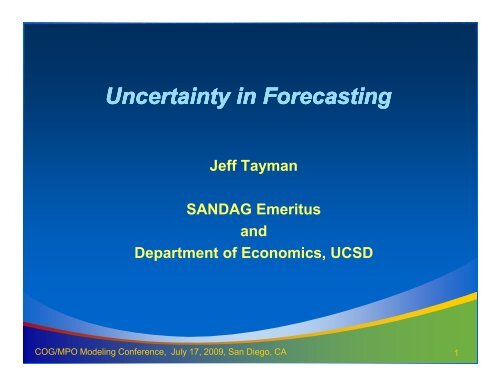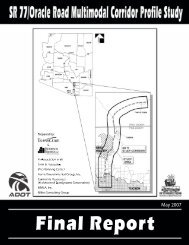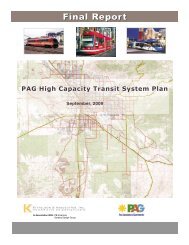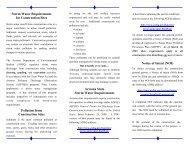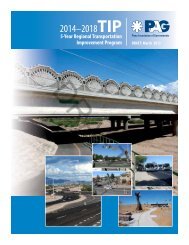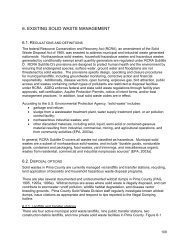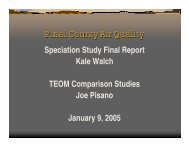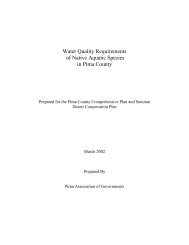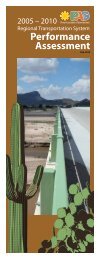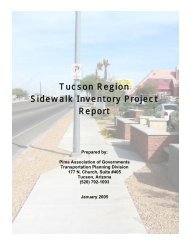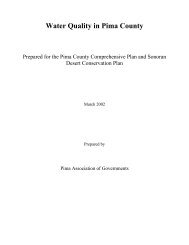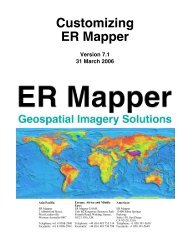Uncertainty in Forecasting
Uncertainty in Forecasting
Uncertainty in Forecasting
Create successful ePaper yourself
Turn your PDF publications into a flip-book with our unique Google optimized e-Paper software.
<strong>Uncerta<strong>in</strong>ty</strong> <strong>in</strong> Forecast<strong>in</strong>g<br />
Jeff Tayman<br />
SANDAG Emeritus<br />
and<br />
Department of Economics, UCSD<br />
COG/MPO Model<strong>in</strong>g Conference, July 17, 2009, San Diego, CA<br />
1
Topics<br />
1. Quandary fac<strong>in</strong>g forecasters<br />
2. Value of understand<strong>in</strong>g forecast uncerta<strong>in</strong>ty<br />
3. Characteristics of forecast uncerta<strong>in</strong>ty<br />
4. Words Matter- Forecast error versus utility<br />
5. Current approaches to forecast uncerta<strong>in</strong>ty<br />
6. Survey of state and regional agencies<br />
COG/MPO Model<strong>in</strong>g Conference, July 17, 2009, San Diego, CA<br />
2
Key Po<strong>in</strong>ts<br />
• Knowledge of the behavior of forecast<br />
uncerta<strong>in</strong>ty is important for users and<br />
producers of forecasts<br />
• Characteristics of forecast uncerta<strong>in</strong>ty is known<br />
for states and counties; <strong>in</strong>formation for<br />
subcounty areas lack<strong>in</strong>g<br />
• Options for <strong>in</strong>corporat<strong>in</strong>g uncerta<strong>in</strong>ty <strong>in</strong>to<br />
forecasts vary <strong>in</strong> resource requirements and<br />
political sensitivity<br />
• 96% of state and regional agencies surveyed<br />
currently or plan to <strong>in</strong>corporate uncerta<strong>in</strong>ty <strong>in</strong>to<br />
their forecasts<br />
COG/MPO Model<strong>in</strong>g Conference, July 17, 2009, San Diego, CA<br />
3
Quandary Fac<strong>in</strong>g Forecasters<br />
• Forecast<strong>in</strong>g is impossible yet unavoidable<br />
• Forecasts are needed for decision-mak<strong>in</strong>g and<br />
must be <strong>in</strong> the form of numbers<br />
• Forecasts <strong>in</strong>variably turn out to be different<br />
than the numbers that occur<br />
• Users demand that forecasts meet standards<br />
of accuracy that exceed those commonly<br />
accepted as reasonable by forecasters<br />
COG/MPO Model<strong>in</strong>g Conference, July 17, 2009, San Diego, CA<br />
4
Value of Understand<strong>in</strong>g<br />
Forecast <strong>Uncerta<strong>in</strong>ty</strong><br />
• Forecast<strong>in</strong>g is an uncerta<strong>in</strong> bus<strong>in</strong>ess<br />
• Presence of uncerta<strong>in</strong>ty is <strong>in</strong>herent <strong>in</strong><br />
management or policy decisions<br />
• Make forecasts more valuable to planners,<br />
policy makers, and the public<br />
• Better decisions regard<strong>in</strong>g potential costs and<br />
benefits that rely on forecasts<br />
• Improve forecast<strong>in</strong>g methods and processes<br />
COG/MPO Model<strong>in</strong>g Conference, July 17, 2009, San Diego, CA<br />
5
General Characteristics of<br />
Forecast Error and <strong>Uncerta<strong>in</strong>ty</strong><br />
COG/MPO Model<strong>in</strong>g Conference, July 17, 2009, San Diego, CA<br />
6
Forecast Error Decreases with Size<br />
Relationship between Population Size<br />
and Forecast Accuracy<br />
6<br />
5<br />
Absolute Percent Error<br />
4<br />
3<br />
2<br />
1<br />
y = a - b 1 * ln(Size) - b 2 * ln(Size) 2<br />
0<br />
1 6 11 16 21 26 31 36 41 46 51 56<br />
Population Size<br />
COG/MPO Model<strong>in</strong>g Conference, July 17, 2009, San Diego, CA<br />
7
Forecast Error Increases with<br />
Increas<strong>in</strong>g Rates of Change<br />
Relationship between Population Growth Rate<br />
and Forecast Accuracy<br />
16<br />
14<br />
Absolute Percent Error<br />
12<br />
10<br />
8<br />
6<br />
4<br />
y = a + b 1 * Pctchg + b 2 * Pctchg<br />
y = a + b 1 * Pctchg + b 2 * Pctchg 2 8<br />
2<br />
0<br />
-35 -30 -25 -20 -15 -10 -5 0 5 10 15 20 25 30 35<br />
Population Growth Rate<br />
COG/MPO Model<strong>in</strong>g Conference, July 17, 2009, San Diego, CA
Forecast Bias is Lowest for<br />
Stable/Slow Grow<strong>in</strong>g Areas<br />
Relationship between Population Growth Rate<br />
and Forecast Bias<br />
15<br />
10<br />
y = a + b 1 * Pctchg - b 2 * Pctchg 2 + b 3 * Pctchg 3 9<br />
Algebraic Percent Error<br />
5<br />
0<br />
-5<br />
-10<br />
-15<br />
-20<br />
-35 -30 -25 -20 -15 -10 -5 0 5 10 15 20 25 30 35<br />
Population Growth Rate<br />
COG/MPO Model<strong>in</strong>g Conference, July 17, 2009, San Diego, CA
Complex Methods Do Not<br />
Out Perform Simpler Methods<br />
States<br />
Average Error Across Age Groups<br />
Launch<br />
Year<br />
Target<br />
Year MAPE MALPE<br />
CCM 7.7 3.6<br />
1980 1990<br />
HP 7.0 2.3<br />
CCM 12.6 -0.1<br />
1980 2000<br />
HP 10.7 -1.3<br />
CCM 4.9 -1.6<br />
1990 2000<br />
HP 5.6 -2.3<br />
Florida<br />
Counties<br />
Launch<br />
Year<br />
Target<br />
Year MAPE MALPE<br />
CCM 10.4 0.4<br />
1980 1990<br />
HP 10.6 0.7<br />
CCM 15.2 -5.7<br />
1980 2000<br />
HP 15.4 -5.0<br />
S. Smith and J. Tayman. 2003. An<br />
Evaluation of Population Projections<br />
by Age. Demography 40: 741-757<br />
CCM 10.9 -3.8<br />
1990 2000<br />
HP 9.5 -3.8<br />
COG/MPO Model<strong>in</strong>g Conference, July 17, 2009, San Diego, CA<br />
10
Forecast Error Increases L<strong>in</strong>early with<br />
Length of Forecast Horizon<br />
Table 13.7. "Typical" MAPEs for Population Projections<br />
by Level of Geography and Length of Horizon<br />
Length of Projection Horizon (Years)<br />
Level of<br />
Geography 5 10 15 20 25 30<br />
State 3 6 9 12 15 18<br />
County 6 12 18 24 30 36<br />
Census Tract 9 18 27 36 45 54<br />
Source: S. Smith, J. Tayman, & D. Swanson. 2001. State and<br />
Local Population Projections: Methodology and Analysis.<br />
Kluwer/Plenum Publications.<br />
COG/MPO Model<strong>in</strong>g Conference, July 17, 2009, San Diego, CA<br />
11
Words Matter<br />
Used Car – Pre-owned Car<br />
Cheap – Inexpensive<br />
Quick and Dirty – Cost Effective<br />
Budget Cut – Right Siz<strong>in</strong>g<br />
Forecast Error – Forecast Utility<br />
COG/MPO Model<strong>in</strong>g Conference, July 17, 2009, San Diego, CA<br />
12
Current Approaches to<br />
Forecast <strong>Uncerta<strong>in</strong>ty</strong><br />
• Alternative Scenarios<br />
– Range of values<br />
– Evaluation of policies and relevant factors<br />
• Statistical Probability Intervals<br />
– Model-based<br />
– Empirically-based<br />
• Role of Experts<br />
COG/MPO Model<strong>in</strong>g Conference, July 17, 2009, San Diego, CA<br />
13
Alternative Scenarios<br />
COG/MPO Model<strong>in</strong>g Conference, July 17, 2009, San Diego, CA<br />
14
Land Use Distribution Scenarios<br />
Current Plans – 19 local plans<br />
County Targets – 18 cities local plans, County<br />
targets & footpr<strong>in</strong>ts<br />
Smart Growth – County targets & footpr<strong>in</strong>ts,<br />
San Diego and Chula Vista<br />
plan updates, commitments from<br />
rema<strong>in</strong><strong>in</strong>g 16 cities<br />
COG/MPO Model<strong>in</strong>g Conference, July 17, 2009, San Diego, CA<br />
15
Hous<strong>in</strong>g<br />
Hous<strong>in</strong>g Unit Growth, 2000-2030<br />
2030<br />
Current Plans<br />
County Targets<br />
Smart Growth<br />
Increases<br />
growth <strong>in</strong><br />
rural East<br />
County<br />
Urban/<br />
Suburban<br />
Baja<br />
California<br />
Western<br />
Riverside<br />
East<br />
County<br />
COG/MPO Model<strong>in</strong>g Conference, July 17, 2009, San Diego, CA<br />
16
Hous<strong>in</strong>g Unit Growth, 2000-20302030<br />
Current Plans<br />
County Targets<br />
Smart Growth<br />
Urban/<br />
Suburban<br />
Western<br />
Riverside<br />
Increases<br />
<strong>in</strong>ter-<br />
regional<br />
commut<strong>in</strong>g<br />
Baja<br />
California<br />
East<br />
County<br />
COG/MPO Model<strong>in</strong>g Conference, July 17, 2009, San Diego, CA<br />
17
Hous<strong>in</strong>g Unit Growth, 2000-20302030<br />
Current Plans<br />
County Targets<br />
Smart Growth<br />
Western<br />
Riverside<br />
Focuses<br />
growth <strong>in</strong><br />
urban/<br />
suburban<br />
Urban/<br />
Suburban<br />
Baja<br />
California<br />
East<br />
County<br />
COG/MPO Model<strong>in</strong>g Conference, July 17, 2009, San Diego, CA<br />
18
Range of Projections<br />
U.S. Population Projections, 2000-2050<br />
(<strong>in</strong> 1,000s)<br />
600,000<br />
500,000<br />
400,000<br />
300,000<br />
200,000<br />
1999<br />
2004<br />
2009<br />
2014<br />
2019<br />
2024<br />
2029<br />
2034<br />
2039<br />
2044<br />
2049<br />
Low Middle High<br />
Internet Release Date January 13, 2000, U.S. Census Bureau<br />
http://www.census.gov/population/www/projections/natproj.html<br />
COG/MPO Model<strong>in</strong>g Conference, July 17, 2009, San Diego, CA<br />
19
Alternative Scenarios<br />
• Easy to see effects of different assumptions/policies<br />
• Does not require new models or expertise<br />
• Gives users choices<br />
• Least costly way to exam<strong>in</strong>e uncerta<strong>in</strong>ty<br />
• No measure of likelihood of occurrence<br />
• May understate true level of uncerta<strong>in</strong>ty<br />
• Fail to capture real world fluctuations<br />
COG/MPO Model<strong>in</strong>g Conference, July 17, 2009, San Diego, CA<br />
20
Model-Based Probability Intervals<br />
COG/MPO Model<strong>in</strong>g Conference, July 17, 2009, San Diego, CA<br />
21
ARIMA Models: Counties<br />
Prediction Intervals Denton County Population, 2008-2030<br />
1,600,000<br />
1,400,000<br />
1,200,000<br />
1,000,000<br />
800,000<br />
600,000<br />
400,000<br />
200,000<br />
2008<br />
11,870<br />
1.9%<br />
2019<br />
134,698<br />
15.3%<br />
2030<br />
318,723<br />
28.3%<br />
Po<strong>in</strong>t<br />
95%LL<br />
95%UL<br />
0<br />
2008<br />
2010<br />
2012<br />
2014<br />
2016<br />
2018<br />
2020<br />
2022<br />
2024<br />
2026<br />
2028<br />
2030<br />
Prediction Intervals Dewitt County Population, 2008-2030<br />
30000<br />
25000<br />
20000<br />
15000<br />
10000<br />
2008<br />
276<br />
1.4%<br />
2019<br />
2,136<br />
10.3%<br />
2030<br />
4,648<br />
22.2%<br />
Po<strong>in</strong>t<br />
95%LL<br />
95%UL<br />
5000<br />
0<br />
2008<br />
2010<br />
2012<br />
2014<br />
2016<br />
2018<br />
2020<br />
2022<br />
2024<br />
2026<br />
2028<br />
2030<br />
COG/MPO Model<strong>in</strong>g Conference, July 17, 2009, San Diego, CA<br />
22
ARIMA Models: States<br />
68 % Prediction Intervals, Forecasts of Selected States<br />
Average of Half-Widths 1<br />
Base Period Length (<strong>in</strong> Years)<br />
Model 10 30 50<br />
ARIMA (1,1,0)<br />
Forecast<br />
Horizon<br />
(<strong>in</strong> Years)<br />
10 9.1 7.3 6.0<br />
20 14.3 10.8 8.9<br />
30 18.5 13.5 10.9<br />
ARIMA (2,2,0)<br />
ARIMA ln(0,1,1)<br />
Forecast<br />
Horizon<br />
(<strong>in</strong> Years)<br />
Forecast<br />
Horizon<br />
(<strong>in</strong> Years)<br />
10 30 50<br />
10 35.5 22.2 16.4<br />
20 93.8 54.2 39.4<br />
30 169.8 90.1 64.9<br />
10 30 50<br />
10 9.7 8.5 7.5<br />
20 17.2 13.6 11.7<br />
30 25.3 18.5 15.4<br />
Percent of Observed Population Counts With<strong>in</strong> Interval<br />
Base Period Length (<strong>in</strong> Years)<br />
Model 10 30 50<br />
ARIMA (1,1,0)<br />
ARIMA (2,2,0)<br />
ARIMA ln(0,1,1)<br />
Forecast<br />
Horizon<br />
(<strong>in</strong> Years)<br />
Forecast<br />
Horizon<br />
(<strong>in</strong> Years)<br />
Forecast<br />
Horizon<br />
(<strong>in</strong> Years)<br />
10 50% 50% 33%<br />
20 42% 42% 17%<br />
30 42% 42% 42%<br />
10 30 50<br />
10 83% 92% 83%<br />
20 100% 92% 92%<br />
30 100% 100% 100%<br />
10 30 50<br />
10 50% 58% 58%<br />
20 67% 67% 58%<br />
30 58% 67% 67%<br />
J. Tayman, S. Smith, & J. L<strong>in</strong>. 2007.<br />
Precision, Bias, and <strong>Uncerta<strong>in</strong>ty</strong> for<br />
State Population Forecasts: An<br />
Exploratory Analysis of Time Series<br />
Models. Population Research and<br />
Policy Review 26: 347-369<br />
1 Half-Width = ((Upper Limit - Lower Limit) / 2 ) / Po<strong>in</strong>t Forecast<br />
COG/MPO Model<strong>in</strong>g Conference, July 17, 2009, San Diego, CA<br />
23
Model-Based Probability Intervals<br />
• Provide explicit probability statements to measure<br />
forecast uncerta<strong>in</strong>ty<br />
• Intervals often exceed low and high ranges;<br />
provide an important reality check<br />
• Valid only to extent underly<strong>in</strong>g assumptions hold<br />
• Models are complex; require expertise beyond <strong>in</strong>-<br />
house capabilities; users f<strong>in</strong>d difficult to<br />
understand<br />
• Alternate models imply different levels of<br />
uncerta<strong>in</strong>ty<br />
• Netherlands only agency us<strong>in</strong>g probabilistic<br />
<strong>in</strong>tervals <strong>in</strong> official projections<br />
COG/MPO Model<strong>in</strong>g Conference, July 17, 2009, San Diego, CA<br />
24
Empirically-Based Probability Intervals<br />
COG/MPO Model<strong>in</strong>g Conference, July 17, 2009, San Diego, CA<br />
25
Empirical Intervals: Counties<br />
Absolute % Error Distributions for U.S. Counties<br />
Target Year<br />
Absolute % Error<br />
Horizon<br />
Length Mean<br />
Std.<br />
Dev. 90 th PE<br />
1930 10 12.2 13.9 29.1<br />
1940 10 11.2 12.4 23.3<br />
1950 10 11.2 11.1 24.9<br />
1960 10 10.3 9.9 23.2<br />
1970 10 9.6 9.7 21.0<br />
1980 10 13.2 10.2 26.3<br />
1990 10 7.8 6.6 15.6<br />
2000 10 6.2 6 13.9<br />
Average 10 10.2 10 22.2<br />
Std. Dev. 10 2.3 2.7 5.2<br />
1950 30 33.1 37.4 78.7<br />
1960 30 32.9 34.5 68.1<br />
1970 30 31.9 31.1 68.3<br />
1980 30 22.1 19.9 49.3<br />
1990 30 29.3 23 60.6<br />
2000 30 27.8 20.3 55.3<br />
S. Rayer, S. Smith, & J. Tayman.<br />
Empirical Prediction Intervals for County<br />
Population Forecasts. Forthcom<strong>in</strong>g<br />
Population Research and Policy Review<br />
Average 30 29.5 27.7 63.4<br />
Std. Dev. 30 4.2 7.6 10.5<br />
COG/MPO Model<strong>in</strong>g Conference, July 17, 2009, San Diego, CA<br />
26
Empirical Intervals: Subcounty<br />
95% Confidence Intervals for Average Errors <strong>in</strong> 1990<br />
for Selected Population Sizes, San Diego County<br />
Size<br />
Lower<br />
Limit<br />
MAPE<br />
Po<strong>in</strong>t<br />
Estimate<br />
Upper<br />
Limit<br />
Interval<br />
Width<br />
500 67.4 72.0 80.3 12.9<br />
1,000 50.5 56.5 59.7 9.2<br />
1,500 42.7 46.2 50.2 7.5<br />
3,000 31.9 33.4 37.4 5.5<br />
5,000 25.7 27.9 30.1 4.4<br />
7,500 21.7 24.4 25.4 3.7<br />
10,000 19.2 20.7 22.5 3.3<br />
20,000 14.3 16.3 16.8 2.5<br />
30,000 12.0 12.4 14.2 2.2<br />
40,000 10.6 11.5 12.6 2.0<br />
50,000 9.7 10.5 11.5 1.8<br />
Elasticity for<br />
Population Size and<br />
MAPE = -0.442<br />
J. Tayman, E. Schafer, & L. Carter.<br />
1998. The Role of Population Size <strong>in</strong><br />
the Determ<strong>in</strong>ation and Prediction of<br />
Population Forecast Errors: An<br />
Evaluation Us<strong>in</strong>g Confidence Intervals<br />
for Subcounty Areas. Population<br />
Research and Policy Review 17: 1-20<br />
COG/MPO Model<strong>in</strong>g Conference, July 17, 2009, San Diego, CA<br />
27
Empirically-Based Intervals<br />
• More useful for small areas than model-based<br />
<strong>in</strong>tervals<br />
• Less complex model<strong>in</strong>g; with<strong>in</strong> capabilities of<br />
<strong>in</strong>-house staff<br />
• Can accommodate alternate error distribution<br />
shapes<br />
• Availability and usability of past forecasts may<br />
be an issue <strong>in</strong> many agencies, especially those<br />
do<strong>in</strong>g subcounty forecasts<br />
COG/MPO Model<strong>in</strong>g Conference, July 17, 2009, San Diego, CA<br />
28
Expert Panels<br />
COG/MPO Model<strong>in</strong>g Conference, July 17, 2009, San Diego, CA<br />
29
San Diego County Water Authority<br />
Probabilistic Water Demand Forecasts<br />
San Diego County Water Authority. 2002. Draft<br />
Regional Water Facilities Master Plan: Appendix C<br />
COG/MPO Model<strong>in</strong>g Conference, July 17, 2009, San Diego, CA<br />
30
Economic Impacts of<br />
Border Wait Times<br />
SANDAG & Caltrans District 11. 2006. Economic Impacts of Wait Times<br />
at the San Diego-Baja California Border.<br />
COG/MPO Model<strong>in</strong>g Conference, July 17, 2009, San Diego, CA<br />
31
Expert Panels<br />
• Use same models, assumptions, and committee<br />
structure as “official forecast”<br />
• Maybe the least costly alternative to produc<strong>in</strong>g<br />
probabilistic forecasts<br />
• Aid <strong>in</strong> the acceptance and understand<strong>in</strong>g of forecast<br />
uncerta<strong>in</strong>ty by stakeholders<br />
• Def<strong>in</strong><strong>in</strong>g who is an expert<br />
• Need rigorous procedures (e.g., Delphi) to challenge<br />
status quo views<br />
• Can be <strong>in</strong>fluenced by dom<strong>in</strong>ant personalities<br />
COG/MPO Model<strong>in</strong>g Conference, July 17, 2009, San Diego, CA<br />
32
Survey of State and Regional Agencies<br />
COG/MPO Model<strong>in</strong>g Conference, July 17, 2009, San Diego, CA<br />
33
Survey Respondents<br />
• Non-Probability Sample<br />
• Agencies have long stand<strong>in</strong>g and respected programs<br />
similar <strong>in</strong> stature to MAG<br />
• 12 of 19 regional agencies responded<br />
• 12 of 18 state agencies responded<br />
• Conducted dur<strong>in</strong>g Dec. 2008<br />
• Three general topics<br />
– How forecast adequacy is assessed<br />
– How uncerta<strong>in</strong>ty is <strong>in</strong>corporated <strong>in</strong>to the forecast<strong>in</strong>g process<br />
– General characteristics of the forecast<strong>in</strong>g process<br />
COG/MPO Model<strong>in</strong>g Conference, July 17, 2009, San Diego, CA<br />
34
Migration is the Highest Ranked<br />
Source of <strong>Uncerta<strong>in</strong>ty</strong><br />
Major Sources of <strong>Uncerta<strong>in</strong>ty</strong> <strong>in</strong> the Long-range Forecast 1<br />
Rank (1 Highest) 2<br />
Percent of Responses<br />
<strong>Uncerta<strong>in</strong>ty</strong> Sources Regional State Regional State<br />
Migration 1.6 1.0 23% 46%<br />
Fertility 4.0 2.0 3% 23%<br />
Mortality 2.0 3.0 6% 15%<br />
Economy/Labor Force 1.8 2.0 14% 4%<br />
Land Uses 1.9 – 23% 0%<br />
Adm<strong>in</strong>istrative/Regulatory 2.0 2.0 3% 8%<br />
Commut<strong>in</strong>g Patterns 2.0 3.0 3% 4%<br />
Model Specification 3.0 – 6% 0%<br />
Availabliity of Infrastructure 2.0 – 3% 0%<br />
U.S. Forecasts 3.0 – 3% 0%<br />
Prices, Costs 4.0 – 3% 0%<br />
Household Size/VR 4.0 – 6% 0%<br />
Ag<strong>in</strong>g of Households 3.0 – 3% 0%<br />
Changes <strong>in</strong> Technology 4.0 – 3% 0%<br />
All Responses 100% 100%<br />
1 Respondents could select more than one variable.<br />
2<br />
Average of ranks<br />
Source: 2008 survey of state and regional agencies.<br />
COG/MPO Model<strong>in</strong>g Conference, July 17, 2009, San Diego, CA<br />
35
More Regional than State Agencies<br />
Currently Incorporate <strong>Uncerta<strong>in</strong>ty</strong><br />
% Incorporat<strong>in</strong>g<br />
80%<br />
70%<br />
60%<br />
50%<br />
40%<br />
30%<br />
20%<br />
10%<br />
0%<br />
75%<br />
Regional<br />
50%<br />
State<br />
COG/MPO Model<strong>in</strong>g Conference, July 17, 2009, San Diego, CA<br />
36
Only 1 Agency Not Currently or Plann<strong>in</strong>g<br />
to Incorporate <strong>Uncerta<strong>in</strong>ty</strong><br />
Table C-7. Current Status by Anticipated Changes to Incorporat<strong>in</strong>g <strong>Uncerta<strong>in</strong>ty</strong><br />
Changes Anticipated<br />
Changes Anticipated<br />
Currently<br />
Incorporated Yes No Total<br />
Currently<br />
Incorporated Yes No Total<br />
Yes 38% 91% 63% Yes 5 10 15<br />
No 62% 9% 38% No 8 1 9<br />
All Responses 100% 100% 100% All Responses 13 11 24<br />
Source: 2008 survey of state and regional agencies.<br />
COG/MPO Model<strong>in</strong>g Conference, July 17, 2009, San Diego, CA<br />
37
Regional Agencies Use Multiple Methods<br />
for Incorporat<strong>in</strong>g <strong>Uncerta<strong>in</strong>ty</strong><br />
Table C-6. <strong>Uncerta<strong>in</strong>ty</strong> <strong>in</strong> Current Forecast<strong>in</strong>g Process: Approach 1<br />
Percent<br />
Number<br />
Approach Regional State Total Regional State Total<br />
Alternative Scenarios 33% 33% 33% 6 2 8<br />
Range of Values 22% 17% 21% 4 1 5<br />
Expert Panel 33% 0% 25% 6 0 6<br />
Empirical Intervals 6% 17% 8% 1 1 2<br />
Model Intervals 6% 17% 8% 1 1 2<br />
Past Forecasts 0% 17% 4% 0 1 1<br />
All Responses 100% 100% 100% 18 6 24<br />
1 Respondents could select more than one variable.<br />
Source: 2008 survey of state and regional agencies.<br />
COG/MPO Model<strong>in</strong>g Conference, July 17, 2009, San Diego, CA<br />
38
Alternate Scenarios/Range of Values Most<br />
Likely New Approaches to <strong>Uncerta<strong>in</strong>ty</strong><br />
Table C-8. <strong>Uncerta<strong>in</strong>ty</strong> <strong>in</strong> Future Forecast<strong>in</strong>g Process: Approach 1,2<br />
Percent<br />
Number<br />
Approach Regional State Total Regional State Total<br />
Alternative Scenarios 50% 17% 38% 5 1 6<br />
Range of Values 20% 33% 25% 2 2 4<br />
Expert Panel 20% 0% 13% 2 0 2<br />
Empirical Intervals 0% 0% 0% 0 0 0<br />
Model Intervals 10% 0% 6% 1 0 1<br />
Do Not Know 0% 50% 19% 0 3 3<br />
All Responses 100% 100% 100% 10 6 16<br />
1 Respondents could select more than one variable.<br />
2<br />
Incudes respondents who <strong>in</strong>dicated a change <strong>in</strong> practices and new approaches not<br />
currently be<strong>in</strong>g used.<br />
Source: 2008 survey of state and regional agencies.<br />
COG/MPO Model<strong>in</strong>g Conference, July 17, 2009, San Diego, CA<br />
39
State and Regional Agency<br />
Spend<strong>in</strong>g Priorities Differ<br />
State and Regional Agency Spend<strong>in</strong>g<br />
on Forecast<strong>in</strong>g Activities<br />
100%<br />
90%<br />
$21<br />
`<br />
$15<br />
Average of $100 allocated<br />
80%<br />
70%<br />
60%<br />
50%<br />
40%<br />
30%<br />
20%<br />
$15<br />
$22<br />
$26 $26<br />
$38 $37<br />
Database Management<br />
<strong>Uncerta<strong>in</strong>ty</strong> and Error<br />
Data Development<br />
Model Enhancement<br />
10%<br />
0%<br />
Regional<br />
State<br />
2008 survey of state<br />
and regional agencies<br />
COG/MPO Model<strong>in</strong>g Conference, July 17, 2009, San Diego, CA<br />
40
Website URL of <strong>Uncerta<strong>in</strong>ty</strong> Report<br />
http://www.mag.maricopa.gov/detail.cms?item=10300<br />
COG/MPO Model<strong>in</strong>g Conference, July 17, 2009, San Diego, CA<br />
41


